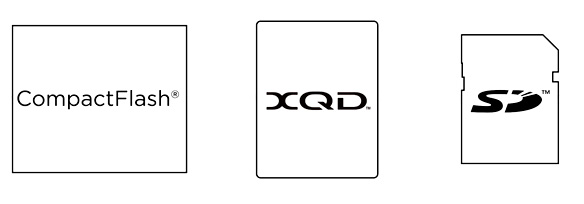Jan 2021 Update: The IQ4 has been updated to be compatible with CFexpress cards as discussed in the article below. This is now the preferred card format for the IQ4 as card speeds currently (as of this update) exceed 1700 MB/sec read and 1200 MB/sec write. A list of recommended/tested such cards are here.
Given that the Phase One IQ4 uses CFexpress, XQD and SD storage, whereas previous IQ backs used CF Cards, we thought our users would benefit from a run down of camera storage technology circa 2018. Why did Phase One choose XQD and SD?
We can think of few topics more dull than storage card technology. Moreover, no one likes buying new storage cards, let alone changing out their entire inventory of them. But storage cards are the lifeblood of portable photography, and as technology marches on we must swap out storage types. Otherwise we’d all still be carrying around Sony Mavicas shooting to 3.5” floppy disk storage.

This article will empower you with the information so you can:
- Switch the card types you buy/have as infrequently as possible
- Avoid switching to dead-end storage
- Avoid overbuying or underbuying speed or size
Technology Comparison
|
CF |
CFast |
CFexpress |
SD |
XQD |
|
|
Year first iteration shipped |
1994 | 2008 | 2018 | 2010 | 2011 |
|
Maximum Theoretical Write-Speed of Platform |
~170 MB/s |
~600 MB/s |
~8000 MB/s |
1000 MB/s**** |
~1000 MB/s |
|
Max write-speed available today |
~200 MB/s (UDMA 7) |
~450 MB/s (CFast 2.0) |
~1000 MB/s** (CFexpress 1.0) |
~300 MB/s (UHS-III) |
~400 MB/s (XQD 2.0) |
|
Size (mm) |
36.4 x 42.8 x 3.6 |
36.5 x 42.8 x 3.6 |
38.5 x 29.8 x 3.8 |
32 x 24 x 2.1 |
38.5 x 29.8 x 3.8 |
|
Weight (grams) |
10 |
10 |
9 |
2 |
9 |
|
~Cost for low-end (slow, offbrand) 128gb cards |
Not Yet Shipping |
None available, only Lexar and Sony |
|||
|
~Cost for high-end (fast, Lexar or Sandisk) 128gb cards |
Not Yet Shipping |
||||
|
Forward/Backward Compatibility (if any) |
None |
None |
CFexpress should work in XQD slots via firmware update |
None |
CFexpress should work in XQD slots via firmware update |
*Note that all speeds have been rounded to the nearest 10 MB/s to improve readability. For example CF cards have a maximum theoretical speed of ~167 MB/s and thus are rounded to ~200 MB/s.
**CFexpress cards have been publicly demonstrated and sample cards have been sent to manufacturers, but the first end-user cards are not expected to ship until Q3-2018.
****The current SD specification is SD 6.0 and is limited to a maximum theoretical write-speed of ~650 MB/s. A future SD 7.0 specification has been proposed that uses the PICe rather than UHS-III bus, which would allow 1000 MB/s.

Size comparison of XQD, SD, and CF
Adoption and Support Comparison
Remember, Beta was widely considered the technologically superior format, but investing in a Beta Max based workflow proved to be a terrible investment for most users due to VHS winning the adoption/support battle.
|
CF |
CFast/CFast 2.0 |
CFexpress |
SD |
XQD |
|
|
Current Cameras offering support |
Nikon D5 Nikon D850 Phase One IQ3 Canon 5D S/S R Canon 5D Mk IV |
Canon 1D X Mk II Hasselblad H6D-100c/50c |
Nothing yet |
All major Nikon (other than D5), Canon (other than 1D X Mk II), Sony, Fujifilm, Olympus, Panasonic, Pentax cameras Hasselblad H6D-100c/50c Hasselblad X1D-50c Fujifilm GFX-50s |
Phase One IQ4 Nikon Z series Nikon D5 Nikon D500 Nikon D850 |
|
Industry groups and companies endorsements |
No one anymore |
Hasselblad Canon Arri Bllackmagic |
CompactFlash Association |
Ubiquitous |
Nikon, Phase One, Sandisk, Sony |
Conclusions
When Phase One began working on the IQ4 platform they evaluated the storage landscape and came to the following conclusions:
- CF: The Old Guard. CF had a good, long run. But that run is over. As Phase One cameras grew in resolution and capture speed the CF card specification kept up, growing faster and faster until it hit the hard limit of the specification: 167 MB/s. That speed was (just barely) fast enough to fully leverage the maximum capture rate of the Phase One IQ3 100mp Trichromatic, but it is too slow to handle the maximum capture rate of the IQ4 150mp. Using CF in the IQ4 would have constrained its performance.
- CFast: The Dead Usurper. CFast was first launched in 2008 (CFast 2.0 came four years later) as the intended successor to CF. At the time it was released it was quite fast compared to its peers, but it lost its performance edge to SD and XQD cards. In 2018 it appears to be a technological dead end. The main industry organization, CFA, that was advocating for it has abandoned it, instead throwing its weight behind CFexpress. CFast isn’t forward or backward compatible to anything else and, to add insult to injury, is still very expensive on a dollar-per-performance basis. This makes CFast a poor choice for a new platform.
- SD: The Aging King. SD cards are ubiquitous. A ton of currently-shipping cameras still use them, and in a pinch you can even find them for sale in gas stations. As a very mature technology SD made sense for Phase One to include, but being limited to only SD could be expected to become a significant limitation sooner rather than later.
- XQD: The Next King. XQD is the current king of performance with growing adoption in high-end cameras and wide industry support. Most importantly, it’s forward compatible to the CFexpress standard that will likely overtake it in the coming years.
- CFexpress: The Crown Prince. The CFexpress standard is just getting off the ground. As industry pivots away from the largely-failed CFast specification it will likely be pivoting to CFexpress. It provides, by far, the most headroom for future performance. As with any standard that is just getting off the ground, the future of CFexpress is more uncertain than with more mature options like SD. Phase One has done everything it can with the IQ4 to prepare it for CFexpress. It’s very likely that Phase One will add support for CFexpress via a Feature Update after that standard has further solidified, but no promises of this have been made.
Testing
We will be posting the results of testing the IQ4 with different card types next week. Stay tuned!
Bottom Line:
Many of our customers purchased high-end CF cards in the late 2000s and have been using them for nearly a decade. For example the SanDisk 64gb Extreme Pro was released in late 2009 and is still a reasonable card to use in an IQ3 100mp. Such customers now have to replace their entire inventory of CF cards with some new type of card. What should those customers do today to have the greatest chance of using the new cards for the next decade?
CFexpress: CFexpress looks to be the answer in the long term, and will likely work in the IQ4, making the IQ4 storage options as future proof as possible.
XQD: In the meantime the XQD is incredibly fast and is available today. It’s also gained recent traction with its inclusion with the Nikon Z series that will help drive production volumes and lower prices.
SD: The performance of a fast/quality SD card in the IQ4 is quite good, even if it’s not quite as fast as with a fast/quality XQD card. You may already own some large high-quality SD cards that you use in other cameras.
So our bottom line suggestion for those buying an IQ4: If you already own fast/quality SD cards, test to see if you’re comfortable using them as a stop-gap while you wait for XQD cards to come down in price. if you’re starting from scratch, or want the absolute best performance, then buy XQD cards.

